YOU ARE HERE >> AmazingRibs » Ratings & Reviews » Ratings Reviews And Buying Guides » AmazingRibs.com Gift Guide for BBQ and Grilling » BBQ Gifts $500+ » Weber Spirit II E-310 Gas Grill Review
Weber Spirit II E-310 Gas Grill Review
All of our reviews are done independently by our team of testers and are in no way influenced by advertising or other monetary compensation from manufacturers. Click here to learn more about our unbiased product review process.
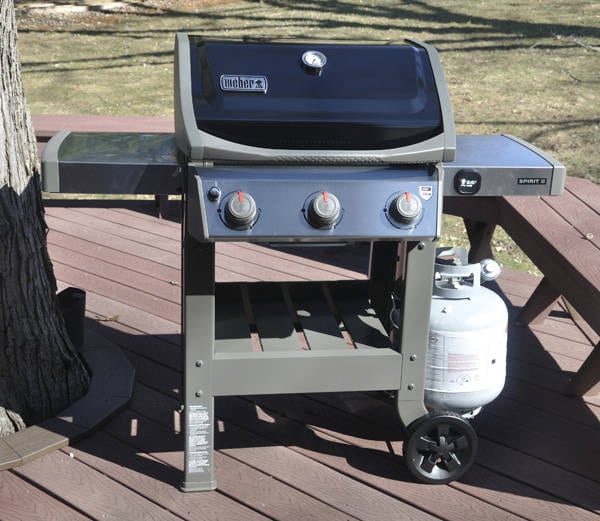
For 2018, Weber sticks to the basics with a revamped version of their popular, full-size, entry-level Spirit gas grill line. Like its predecessor, Spirit II is a workhorse that delivers solid performance and is easy to use, easy to clean and available in two and three burner configurations. Increasingly cuckoo for color, Weber offers Spirit in black, ivory, red, sapphire, exclusive mocha versions for Lowe’s and exclusive stainless steel versions for Home Depot.
Spirit II E-310 features Weber’s new GS4 grilling system consisting of their battery powered Infinity Ignition, three 10,000 BTU stainless steel burners, and the tried and true porcelain enameled steel “flavorizer” bars and grease management system. The enclosed cart with doors is gone. Spirit II has four legs, two wheels and a lower open-air storage rack.
Why the revision? I speculated it may be a cost cutting measure, but Weber responded, “the tank was moved to the side of the grill for easy access. The open cart was designed to have easy access to tools in the rack below”. In any case, prices for the new Spirit II are unchanged from the previous model.
GS4 Grilling System
For the most part, Spirit’s GS4 Grilling System is similar to the previous Spirit line. One big difference is the fire box. The last Spirit Series had cast aluminum sides with a large, slide out grease tray that doubled as firebox bottom. Spirit II has a single piece, cast aluminum fire box with a funnel shaped bottom that diverts grease into a small slide out grease tray (see below).
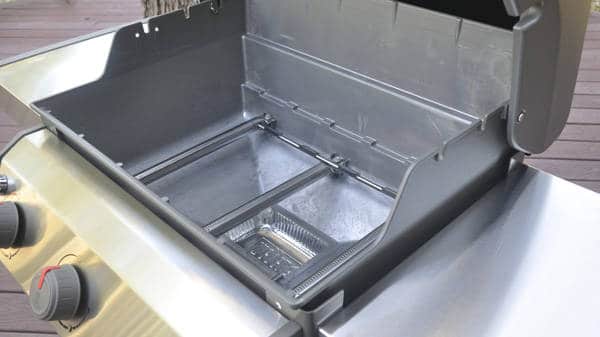
This fire box design holds and radiates heat evenly, perhaps making up for a lid that seems slightly light weight. As for clean up, it’s as easy as can be. The small grease tray slides out from the front and disposable foil liners are available. Simply scrape any accumulated grease and gunk from the funnel walls into the tray now and then.
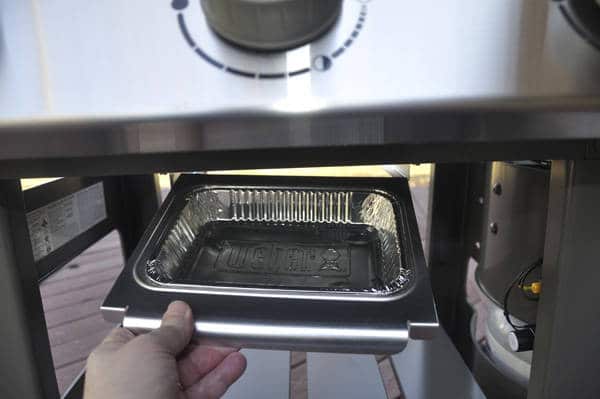
In windy conditions, a gap between the grease tray and firebox hole could disrupt airflow in the grill. To minimize this possibility, Weber includes a “Heat Diffuser” (shown below).
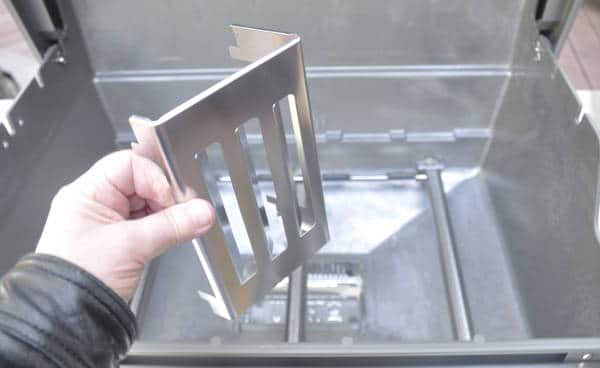
The diffuser pops in place under the middle burner. Attention to detail such as this is one reason the Weber name commands higher prices than many mass market brands. Weber’s price tag also includes quality construction and the best customer service from a manufacturer in the business, on call seven days a week from 7am to 9pm CST.
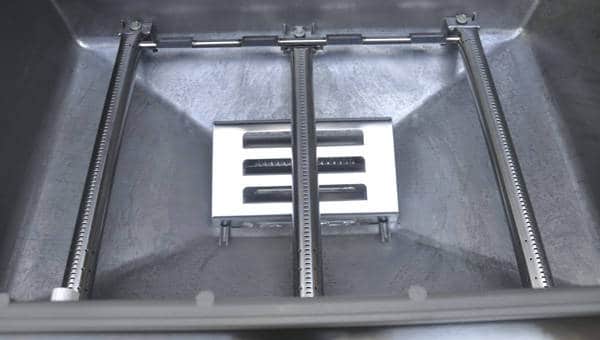
Most gas grills use metal heat tents under the cooking grate to disperse heat, protect the burners, and to sizzle drippings that impart flavor to foods. Cheap gassers often have only one tent over each burner. Better quality grills, like Spirit II, blanket the entire cook box for more even heat and more delicious sizzle (see below). Weber famously calls their tents “Flavorizer Bars”. Note the notches on the sides of each bar which provide a visual confirmation that the burners beneath them are indeed lit.
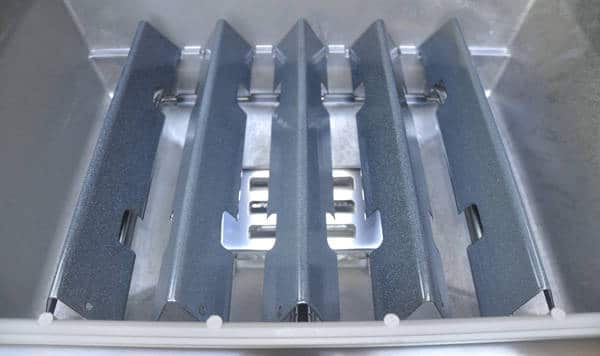
Reversible porcelain enameled cast iron grates
Reversible cooking grates aren’t unusual, but Spirit II grates are a little different than most. Spirit II reversible grates have a thin side which Weber believes is “ideal for food such as shrimp and fish”, and flat side which “creates a thick sear mark”. We’re not typically fans of cast iron grates because they overpower foods with intense conductive heat at the point of contact, creating the alternating bands of dark brown and pale tan known as sear marks. Click here to learn about grill grate designs. The ultimate goal is an evenly dark brown crust across the entire surface of the meat, which transforms dull, tan meat to a delicious flavorful crust thanks to the magical Maillard reaction.
A red hot bed of fire on a charcoal grill creates a blend of radiant, convection and conduction heat that can out-sear most gas burners, particularly in this price range. Gas grill manufacturers often rely on cast iron conduction to amplify the gas burner heat and at least add some brown sear marks to food surfaces. Some grillers have discovered a cast iron pan or griddle on their gasser works even better and effectively sears the entire meat surface. Below is an older set of Weber cast iron grates. Note that the cast iron grates are not as wide as the opening between them.
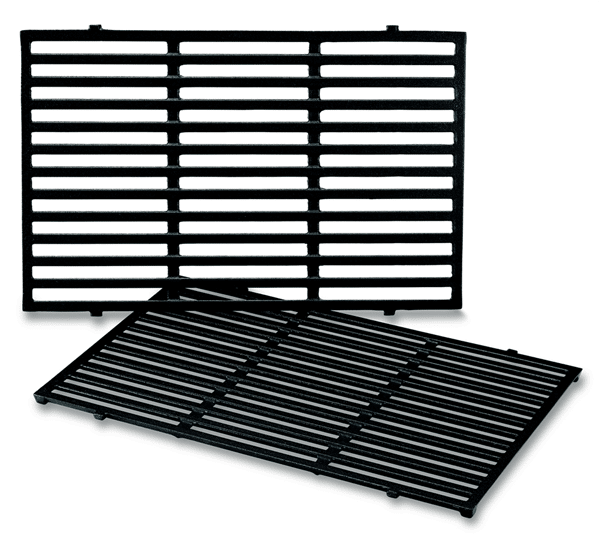
The flat side of the Spirit II grill grate is half cast iron for better heat conduction and searing, and half open for radiant and convection cooking (see below).
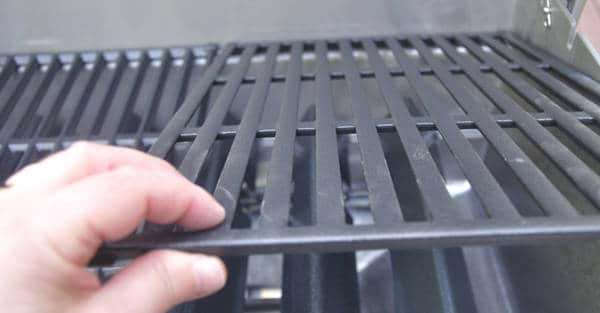
The extra iron produces a hybrid cooking experience somewhere between a solid griddle and a standard grill grate, searing while allowing the flavor and aroma of sizzled drippings to permeate the food. Click here for more info on conduction, convection and radiant cooking. Additionally, the relatively small openings between the grates prevent items like shrimp from falling into the fire. Cooking temp on the Spirit II is pretty even, with the back of the grill running slightly hotter than the front. On a cold day with ambient temperatures in the upper 30°F range and all three burners on the low setting, Spirit II registered temps of about 410°F in front and 440°F in back. With all burners on High, temps were about 600°F front and 680°F back.
We cooked a grillfull of pre-made one-third pound hamburgers on high with the lid down. They cooked fast at two minutes per side, although the front row needed an additional minute. We’d prefer overall, even heat from the front to the back of the grill, but we appreciated how quickly and easily Spirit II cooked this popular item. The burgers were remarkably juicy, perhaps due to the fast cook time.

Steak fajitas anyone? We tried this popular item on the grill as well. For the veggies, we stuck with the two minute per side formula.
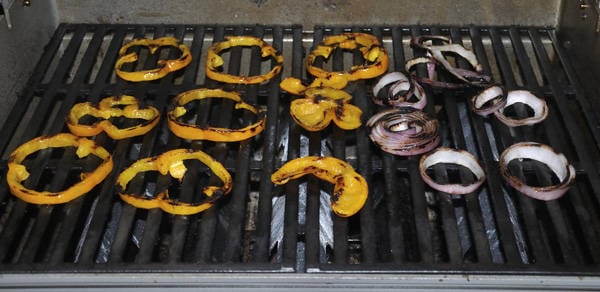
For the steak, we used thin flank steak and cooked it with the old fashioned crosshatch grill mark method: grill two minutes on one side, then rotate 45 degrees, grill two minutes more, then flip and repeat on the other side for a total of about four minutes per side. Of course we don’t cook by time, but by internal meat temp. We cooked the steak until our accurate, instant read digital thermometer registered an internal temp of 130°F for medium-rare. Click here to learn about the importance of digital thermometers.
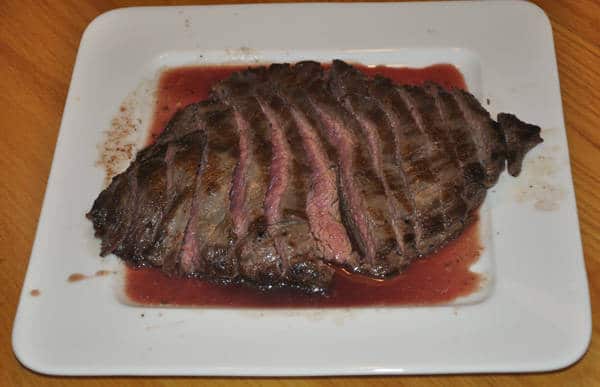
The flank steak was cooked just right for fajitas. Not exactly steakhouse quality, but not bad by any means.
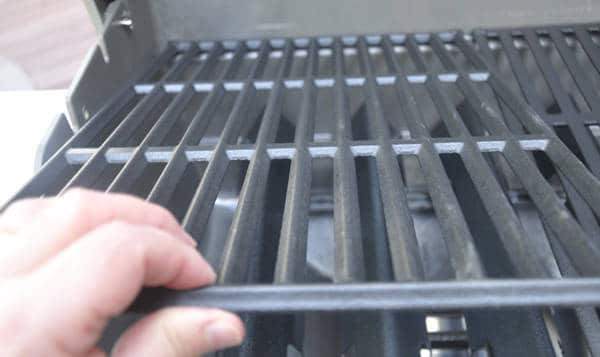
Whole chicken or turkey are good candidates for the thin side of the grates. So we cooked a whole chicken. You want to cook whole birds evenly at moderate temperatures to slowly crisp the skin. With all burners on low, the temp range of around 420°F was a bit too hot for slow roasting a chicken, so we changed course and went for a 2-zone setup following Weber’s instructions to turn off the middle burner, leaving the left and right burners on Low. Then we placed the chicken in the middle in the indirect heat zone. Click here to learn more about the essential technique of 2-zone cooking.
To monitor the cooking temperature, we generally don’t rely on thermometers built into the hood. They are notoriously inaccurate. Instead, we placed our digital thermometer in the middle area, and it registered a cooking temp of 295°F. The sweet spot for roasting chicken is 325°F. At that temperature, poultry cooks gently and thoroughly while developing delicious brown skin. Cook too low and you risk dry meat and rubber skin; too high and you may have to snatch the bird off the grill to prevent burning the outside before the bird is properly cooked inside. We dialed up 325°F by goosing the left and right burners to Medium. Voila! Crisp and juicy chicken.
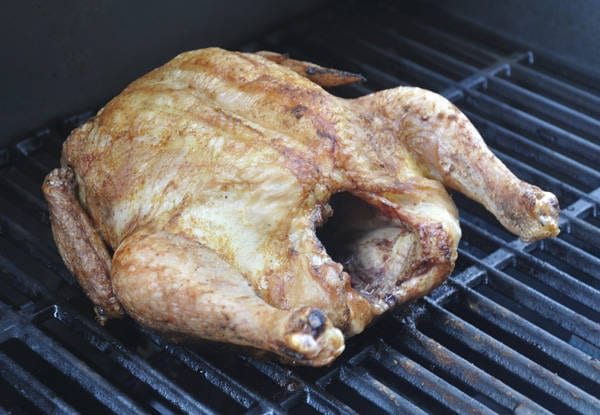
iGrill3
Our main complaint for just about every grill is the obligatory bi-metal dial thermometer in the hood that gives you a ballpark reading of what the temperature is high above the meat. Since we cook down on the grates, it’s always better to use your own digital thermometer and place a probe at the cooking surface. With their acquisition of iGrill digital thermometers, Weber is addressing this issue. Spirit II is “iGrill3 Ready” with a mounting place on the right side shelf for an optional iGrill 3 digital thermometer. This Bluetooth device enables you to place one digital probe at the cooking surface to dial up the correct oven temp, and one probe in your food to monitor internal meat temp. The concept is a big leap in the right direction. Surprisingly, however, there is no read out on the iGrill 3 itself. You need to use the app even when you’re standing at the grill. Check out Weber’s iGrill 3 video below that shows how to install this optional thermometer on their Genesis II.
Infinity Ignition
Weber claims their new Infinity Ignition is significantly enhanced, more robust and consistent. They back up the claim by increasing the warranty on the ignition from two to ten years. You fire Spirit II up by turning the left control knob to HIGH then pressing the ignition button. A crossover flame runs from left to right to ignite the middle and right burners. Throughout our limited time testing Spirit II, we were impressed by the flawless ignition performance.
Racks and shelves
A warming rack and fold down left side shelf are included with Spirit II. The left and right side shelves have integrated tool hooks. Spirit II is also offered as a 2-burner. Both sizes have the same features and are available in LP and natural gas models. LP models have Weber’s Fuel Gauge, which estimates your gas tank level by weight.
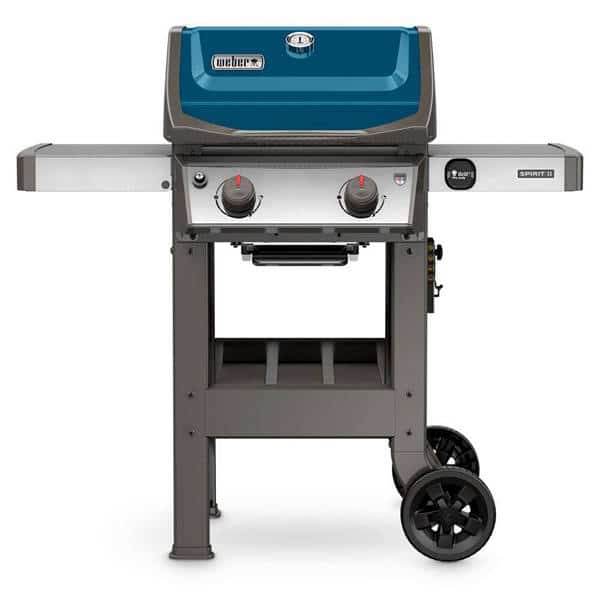
Conclusion
Spirit II continues to be a solid, dependable tool for aspiring backyard pitmasters and pitmistresses. With the multitude of $300 gas grills invading the BBQ market every year, a big challenge Weber always faces is price. Although Spirit II is Weber’s entry level full-sized gas grill line, it is still more expensive than many popular low cost brands. However, most Spirit owners feel that Weber’s quality, durability, performance and customer service are worth it. Many cheapo gassers only last three to four years while Spirits can keep grilling for decades. Manufacturer’s Suggested Retail Prices on Spirit II 3-burner and 2-burner grills are $599 and $499 respectively, but the street price is about a hundred bucks less. Those who take the long view on purchasing decisions could consider Spirit’s $500 (3-burner) and $400 (2-burner) street prices a bargain.
Warranty
The manual states the warranty is 10 years for the cook box, lid, burners, ignition system, and grease management system; five years for the coated cast iron cooking grates and coated steel flavorizer bars. All remaining parts are warranted for two years. However, the Weber website claims the warranty is 10 years on everything. Weber says the website is correct. They explain, “Our new warranty is truly a bumper to bumper 10 year warranty on all Spirit II gas grills, Genesis II gas grills, and Summit gas grills purchased after 10/1/17. What unfortunately has happened is that the reprints for the Spirit II manuals had incorrect information pertaining to our ‘older’ warranty – which was a combination of 10/5/2 years, depending on the component. It’s been addressed and should be corrected in any new future printing of manuals.”
We thank Weber for providing a Spirit II for our tests
Click the buttons below to search our complete database of reviews:
Product Information:
-
Model:Spirit II E-310 Gas Grill
-
Item Price :538.00
*Price Subject To Change -
Where to buy (buying from this supplier supports this website):
-
Made in USA:no
-
Review Method:Cooked On It
We have hands-on experience testing this product. We have also gathered info from the manufacturer, owners and other reliable sources. -
Primary Function:Grill
Grill -
Fuel:Propane Gas, Natural Gas Capable
Propane Gas, Natural Gas Capable -
BTU:30000
30,000 -
Main Burners:3
3 -
Primary Capacity:424 square inches
Mid-Size (about 20 burgers) -
Secondary Capacity:105
105
Manufacturer:
-
Weber-Stephen
Weber-Stephen is one of the oldest and most respected manufacturers of BBQ equipment and related accessories in the world. Weber grills and smokers cook beautifully and have great features that are clever, effective and easy to use. As popularity and demand for BBQ gear grows worldwide, Weber continues to earn their long standing reputation for quality, durability and outstanding customer service and support, (7 days a week from 7am to 8pm CST), in an increasingly competitive environment. Even in this crowded marketplace, many consumers are still willing to pay more for the Weber name and they are rarely disappointed. They make a variety of cookers and smokers. Their iconic black charcoal kettles are known throughout the world. Indeed Weber is expanding globally.
Weber-Stephen was family owned since it was founded in 1952 by George Stephen. At the end of 2010 the Stephen family sold a majority stake to Chicago investment group BDT Capital Partners. In 2012, Weber settled a class action suit out of court regarding their use of the phrase, “Made in USA”. Weber previously qualified the “Made in USA” statement by specifying their products are assembled in the USA with some components that are sourced globally. Here is an excerpt from Weber’s statement “Weber believes that because all Weber grills and the disputed accessories are designed and engineered in the USA, and all grills save for one line [Spirit]* are manufactured and assembled in the USA using component parts primarily made in the USA, it did nothing wrong and therefore has valid defenses to plaintiff’s claims. The court has not held a trial or ruled in favor of either party on any disputed issues. Weber and the plaintiff have agreed to settle the matter to avoid the costs of continued litigation.” As a result of this suit, Weber can no longer claim to be made in America.
Since then Weber, like many others, has outsourced manufacturing of more product lines. Things change, but we believe Weber’s commitment to quality and innovation has not.
The biggest barrier for many folks is price. Webers are not cheap, but when you consider that they last decades, the price is easy to justify. Many some cheap grills fall apart after three years or so.
Our main complaint: All Webers have the obligatory bi-metal dial thermometer in the hood that gives you a ballpark reading of what the temperature is high above the meat. Since we cook on the grates, though, it’s always better to bring your own digital thermometer and place a probe there. It appears this is beginning to change as Weber enters a new era of digital technology and software based products.
Related articles
6/24/2024Published On: 3/30/2018
-
Max Good, AmazingRibs.com’s Full-Time Grill Tester - Max Good is AmazingRibs.com's Vice President of Product Reviews & Keeper of the Flame and is the world's only full-time reviewer of outdoor cooking equipment including smokers, grills, pizza ovens, griddles, and more.
Spotlight
These are not paid ads, they are a curated selection of products we love.
All of the products below have been tested and are highly recommended. Click here to read more about our review process.
Use Our Links To Help Keep Us Alive
Many merchants pay us a small referral fee when you click our “buy now” links. This has zero impact on the price you pay but helps support the site.
Why there is salt in our rub…
When you make rubs at home we recommend you add salt first then the herbs and spices because salt penetrates deep and the other stuff remains on the surface. So thick cuts need more salt. We put salt in these bottled rubs because all commercial rubs have salt and consumers expect it. You can still use these as a dry brine, just sprinkle the rub on well in advance to give the salt time to penetrate. For very thick cuts of meat, we recommend adding a bit more salt. Salt appears first in the ingredients list because the law says the order is by weight, not volume, and salt is a heavy rock.
Sprinkle on one tablespoon per pound of meat two hours or more before cooking if you can. Called “dry brining,” the salt gets wet, ionizes, becomes a brine, and slowly penetrates deep, enhancing flavor and juiciness while building a nice crusty “bark” on the surface. Sprinkle some on at the table too!
Are they hot? No! You can always add hot pepper flakes or Chipotle powder (my fave) in advance or at the table. But we left them mild so you can serve them to kids and Aunt Matilda
Ode to The Pitmaster Club
From TBoneJack, the unofficial Poet Laureate of The Pitmaster Club:
AmazingRibs is where you go,
To get the best advice,
You’ll find out how, to smoke a cow,
And it will turn out nice.
Smokers, gadgets, recipes,
Charcoal, gas, or wood?
The how, the why, and what to try,
When things arn’t going good.
Selection, prep, and cook techniques,
Marinades and such,
Rubs and brines and temps and times,
And how to use the Crutch.
Brisket secrets are revealed,
For moist and tender meat,
The point, the flat, the rendered fat,
The proper mix of heat.
I found out how to smoke spare ribs,
Great bark and taste and worth,
I want some more, I’ll have them for,
My last meal on this Earth.
Memphis Dust did suit them well,
I served them without sauce,
Not 3-2-1, not overdone,
No precious flavor loss.
Jambo, Lang, or Meadow Creek,
It’s hard to make the call,
Almost a crime, so little time,
I’d like to try them all.
I’m not ashamed, I’m not alone,
‘Cause many have this lot,
But I’ll admit, here in the Pit,
My wife said Not! Not! Not!
Weber, Brinkman, PBC,
No need for budget breach,
They cook great food, just ask me dude,
‘Cause I have one of each.
Obsessed I am, I know it’s true,
They call it MCS,
I saw the doc, he was in shock,
He too is in this mess.
Myron Mixon, Johnny Trigg,
Cool Smoke’s Tuffy Stone,
Harry Soo, Chris Lilly too,
And Moe who cooks alone.
They’re all good, I like them fine,
I’m sure they cook good Q,
They’ve earned the right, I see the light,
I’ll give them their fair due,
But I have learned, thru many cooks,
This web site is da bomb,
For what to do, browse over to,
AmazingRibs dot com.
Tired of seeing popup ads?
No need to throw a fit,
Don’t you know, just spend some dough,
And join us in the Pit.
And if you travel, don’t despair,
No further should you look,
The answer’s clear, put down your beer,
And order Meathead’s book.


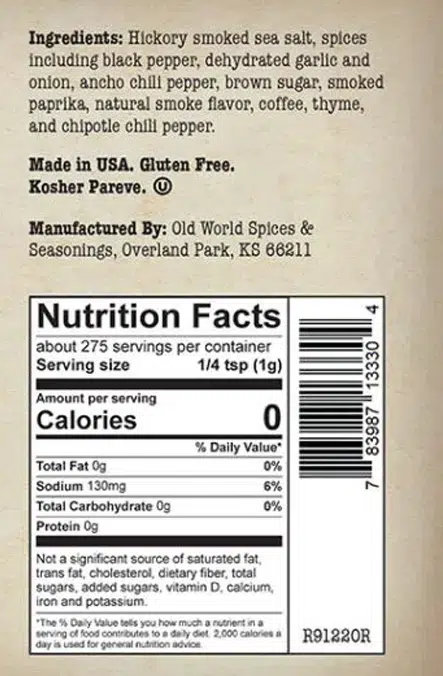



High quality websites are expensive to run. If you help us, we’ll pay you back bigtime with an ad-free experience and a lot of freebies!
Millions come to AmazingRibs.com every month for high quality tested recipes, tips on technique, science, mythbusting, product reviews, and inspiration. But it is expensive to run a website with more than 2,000 pages and we don’t have a big corporate partner to subsidize us.
Our most important source of sustenance is people who join our Pitmaster Club. But please don’t think of it as a donation. Members get MANY great benefits. We block all third-party ads, we give members free ebooks, magazines, interviews, webinars, more recipes, a monthly sweepstakes with prizes worth up to $2,000, discounts on products, and best of all a community of like-minded cooks free of flame wars. Click below to see all the benefits, take a free 30 day trial, and help keep this site alive.
Post comments and questions below
1) Please try the search box at the top of every page before you ask for help.
2) Try to post your question to the appropriate page.
3) Tell us everything we need to know to help such as the type of cooker and thermometer. Dial thermometers are often off by as much as 50°F so if you are not using a good digital thermometer we probably can’t help you with time and temp questions. Please read this article about thermometers.
4) If you are a member of the Pitmaster Club, your comments login is probably different.
5) Posts with links in them may not appear immediately.
Moderators